Atlantic Monthly Contributors's Blog, page 855
December 12, 2013
Bayer Wants You To Know That It Does Not Kill Bees. Bayer Loves Bees
 Shutterstock
Shutterstock The Environmental Protection Agency still isn't sure what has been killing so many honeybees since 2006. The European Union, on the other hand, is pretty sure (based on this study) a pesticide called "neonicotinoid" is the culprit -- enough so that it voted to ban it for the next two years as a precautionary measure.
Bayer makes neonicotinoids. A ban on neonicotinoids would mean less money for Bayer. In what is surely a coincidence, Bayer is convinced that neonicotinoids are not the cause of the bee deaths, but that they are caused by varroa mites. Bayer also makes something called CheckMite, which kills varroa mites. It would be doubly great for Bayer if neonicotinoids were not the cause of bee deaths and varroa mites were.
Bayer cares about bees so much that it built a Bee Care Center in Germany, and plans to build another in North Carolina next year, the New York Times' Danny Hakim reports:
'Bayer is strictly committed to bee health,' said Gillian Mansfield, an official specializing in strategic messaging at the company's Bayer CropScience division. She was sitting at the center's semicircular coffee bar, which has a formidable espresso maker and, if you ask, homegrown Bayer honey. On the surrounding walls, bee fun facts are written in English, like 'A bee can fly at roughly 16 miles an hour' or, it takes 'nectar from some two million flowers in order to produce a pound of honey.'
While others point at pesticides, Bayer has funded research that blames mites for the bee die-off. And the center combines resources from two of the company’s divisions, Bayer CropScience and Bayer Animal Health, to further study the mite menace.
'The varroa is the biggest threat we have' said Manuel Tritschler, 28, a third-generation beekeeper who works for Bayer. 'It’s very easy see to them, the mites, on the bees,' he said, holding a test tube with dead mites suspended in liquid. 'They suck the bee blood, from the adults and from the larvae, and in this way they transport a lot of different pathogens, virus, bacteria, fungus to the bees,' he said.
According to Bayer's CropScience blog, 2013 was a great year for Bee PR in America. It had a Bee Care Tour across America. It celebrated National Pollinator Week by hosting "employee, community and Congressional events to celebrate the contribution pollinators make to the world's food supply." It had a reception in Washington D.C. with "Congressional staff." Lots of great things happened with regards to bees and Bayer.
(Speaking of Washington D.C.: three days ago, the EPA was sued by several bee organizations to force it to reconsider its approval of a Dow neonicotinoid pesticide [the EPA instead asked Dow to put warning labels on the product saying that it "can kill bees and other insect pollinators"].)
When Bayer isn't trying to save bees by creating more chemicals, it's funding studies that "prove" its pesticides aren't fatal to bees and suing the European Union (yes, the European Union, the 28-country-strong 2012 Nobel Peace Prize winner) to try to get the ban on its pesticides revoked.












Twitter Blocking Was Pointless, But Now It's Not
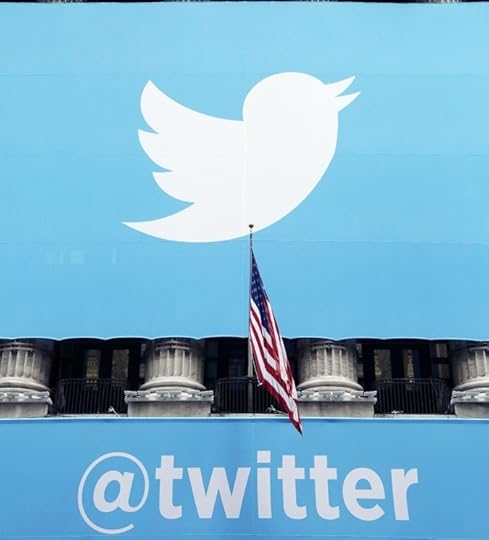 AP
AP Ah, Twitter Blocking. The tool of choice for the social-media-savvy-but-passive-aggressive user (also for people who keep getting spammed and don't want to see cheap iPad offers filling up their @ mentions).
Blocking didn't do much, really. Unless your account was private, the blockee could still see your tweets. He just couldn't follow or re-tweet you. But it was comforting to know that you slightly inconvenienced your blockee, wasn't it?
Perhaps best of all, he'd know you blocked him because if he tried to follow you, this happened:

So satisfying.
But no longer! Yes, Twitter has changed its blocking policy. Now, it says, "if you block another user, that user will not know that you have blocked them."
With this new policy, unless your account is protected, the blockee can still follow you, add you to lists, see your tweets in his timeline, etc. The blockee can see everything!
As for the blocker ...
When you block them, you will no longer see:
The user in your follower list Any updates from that user in your Home timeline, including any of their Tweets that were retweeted by accounts you follow Their @replies or mentions in your Connect tab Any interactions with that user's Tweets or account (i.e., favorites, follows or Retweets) in your Interactions or Activity tabs
... which effectively renders block useless. Or, as BuzzFeed's John Herrman writes: "Blocking is no longer an assertive act that sends a clear 'I don't want to talk to you' message. It's just a quiet button."
People are furious:
I have people who have harassed and threatened me blocked. Did they really get rid of the block? @twitter if so I have go delete my acct.
— Amanda (@AWitchyChick) December 13, 2013
The new Twitter block policy is like hearing men sexually harass women in the street and giving the women earplugs. #RestoreTheBlock
— Joseph Nobles (@BoloBoffin) December 13, 2013
Have yet to see a plausible explanation how the new block policy helps anyone but the people who were getting blocked.
— James Poniewozik (@poniewozik) December 13, 2013
Dear @twitter The new block policy will allow users that make threats to perpetuate the behavior. Have you not studied their hive behavior?
— Lizz Winstead (@lizzwinstead) December 13, 2013
Dear @Twitter , #RESTORETHEBLOCK is happening because your new block policy facilitates a spectrum of abuse on your service. Please listen.
— Warren Ellis (@warrenellis) December 13, 2013
Not having block is an inconvenience for me, but a genuine danger for others. #RestoreTheBlock
— Jacques Frost (@jephjacques) December 13, 2013
As a victim of cyberstalking, @Twitter, I beg you to reverse the changes to the block feature so I can protect myself http://t.co/kAlEYA643L
— Stephanie Haberman (@StephLauren) December 13, 2013
You can still manually block people by having them killed.
— Alison Forns (@alisonforns) December 13, 2013
Others don't think it's a big deal:Trans women don't just get messages of hate; they are threatened daily. A useless block function puts their lives at risk, @twitter.
— Lauren Rankin (@laurenarankin) December 12, 2013Other
Re block backlash: If you have a public Twitter account & used "Block" to keep ppl from reading your tweets, you were doing it wrong.
— Kashmir Hill (@kashhill) December 13, 2013
Personally, I think the new way Twitter handles blocks makes a lot more sense and will be more effective. http://t.co/BVWfxcIWf3
— Judd Legum (@JuddLegum) December 13, 2013
As a woman who was stalked and under police supervision for 3 mos, Twitter's block status changes wouldn't have stopped the stalking.
— Erin Doland (@erdoland) December 13, 2013
On the plus side, organizations/individuals can't block journalists from following them w/o privatizing accounts http://t.co/qZENEua3Ne
— John McQuaid (@johnmcquaid) December 12, 2013
A Twitter spokesperson Jim Prosser told Forbes' Kashmir Hill that the change was made to help victims of Twitter harassment, not hurt them:
'We saw antagonistic behavior where people would see they were blocked and be mad,' says Prosser. He also says 'block' doesn't really make sense when the content is still visible. 'Twitter is public, we want to reinforce that content published in a public profile is viewable by the world.'
... or just reinforce it to the advertisers it needs to bring it to profitability, as will soon be demanded by all those new shareholders.
Update, 10:47 pm ET: Looks like all those angry tweets got to Twitter. It just announced that it's going back to the old block rules and pretending this whole thing never happened:
Earlier today, we made a change to the way the 'block' function of Twitter works. We have decided to revert the change after receiving feedback from many users – we never want to introduce features at the cost of users feeling less safe. Any blocks you had previously instituted are still in effect.
In reverting this change to the block function, users will once again be able to tell that they’ve been blocked. We believe this is not ideal, largely due to the retaliation against blocking users by blocked users (and sometimes their friends) that often occurs. Some users worry just as much about post-blocking retaliation as they do about pre-blocking abuse. Moving forward, we will continue to explore features designed to protect users from abuse and prevent retaliation.
We’ve built Twitter to help you create and share ideas and information instantly, without barriers. That vision must coexist with keeping users safe on the platform. We’ve been working diligently to strike this balance since Twitter’s inception, and we thank you for all of your support and feedback to date. Thank you in advance for your patience as we continue to build the best – and safest – Twitter we possibly can.
Sure enough ...

Damn!












Chemical Weapons Were Used At Least Four Other Times in Syria, UN Says
 United Nations Secretary General Ban Ki-Moon, right, receives the UN Mission to Investigate Allegations of the Use of Chemical Weapons in the Syrian Arab Republic's final report from mission head Professor Åke Sellström. (AP)
United Nations Secretary General Ban Ki-Moon, right, receives the UN Mission to Investigate Allegations of the Use of Chemical Weapons in the Syrian Arab Republic's final report from mission head Professor Åke Sellström. (AP) The United Nations has finally issued its report on whether or not chemical weapons were used in Syria. The verdict: they were -- at least five times -- but we still don't know which side used them.
This was a more comprehensive report than the one the UN issued in September, which said that sarin gas was definitely used in the August 21 attack on Damascus. Now, the UN says, it has found evidence that "suggests" (in the words of the 82-page UN report) that sarin gas was used in at least four other attacks, all in 2013: Khan al Assal on March 19, Saraqueb on April 29, Jobar on August 24 and Ashrafiah Sahnaya on August 25. Twenty-one people are believed to have been killed in those attacks.
The UN's wording wasn't a strong in those four as it was for the site of the August 21 attacks, which killed almost 1,500 people. There, the UN said, the evidence was "clear and convincing." At the other sites, the UN collected evidence that "corroborated" or was "consistent with" allegations that chemical weapons were used. Those included blood tests, samples taken from a victim's internal organs and the attack survivors' symptoms.
Much like it did in the September report, the UN stayed away from assigning blame for the attacks. The United States has maintained that Syrian president Bashar al-Assad was behind the August 21 attacks, though Seymour Hersh recently wrote that the Obama administration hid evidence that the rebels were able to make and use sarin gas. Assad has always blamed the rebels.
Upon receiving the final report, UN Secretary General Ban Ki-moon said: "The use of chemical weapons is a grave violation of international law and an affront to our shared humanity. We need to remain vigilant to ensure that these awful weapons are eliminated, not only in Syria, but everywhere. "
Ki-moon is scheduled to say more on Friday and Monday, once he's had a chance to read the report.
After the August 21 attack, Assad agreed to let the Organization for the Prohibition of Chemical Weapons destroy its chemical weapons. But the weapons couldn't be destroyed in Syria, as it's in the middle of a civil war, and Albania refused to host them. Instead, the weapons will be destroyed aboard a U.S. ship somewhere in the middle of the ocean in a process an unnamed official assured reporters was "environmentally sound."
Alternately, Croatia might do it.
Yesterday, amid reports of increased fighting between rebel groups, the United States decided to stop providing non-military aid to the rebel-controlled region of northern Syria.












House Overwhelmingly Passes the Budget Compromise
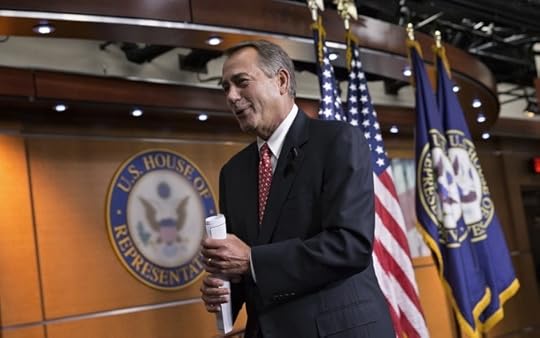 AP
AP The House voted to pass a compromise budget plan drafted by Rep. Paul Ryan and Sen. Patty Murray that would fund the government through 2015. Despite opposition from conservative groups who disagreed with the bill's partial relief to sequester cuts, the bill easily passed the Republican controlled House, 332-94. The two-year deal funds the government at just above $1 trillion for 2014 and 2015, ending a years-long cycle of short term deals to keep the government open.
Earlier on Thursday, Speaker John Boehner blasted conservative opposition to the compromise, arguing that outside groups who opposed the budget deal had "lost credibility." On Wednesday, Boehner called the opposition efforts "ridiculous." Republicans ended up voting for the measure 169-62, while Democrats supported it 163-32.
If passed in the Senate, the $85 billion package would relieve about $63 billion in scheduled sequestration cuts starting in 2014, with the remaining savings going towards the country's deficit. The savings come from cuts to other programs, along with a series of increased fees, including a raise in employee contributions to federal pensions. The bill does not include a key provision for Democrats: an extension of long-term unemployment benefits, set to expire December 28.
The bill now moves to the Senate for a vote some time next week. President Obama has promised to sign the bill into law should it pass.












Scott Brown Loves New Hampshire Because It Won't Make Him Wear a Lame Helmet
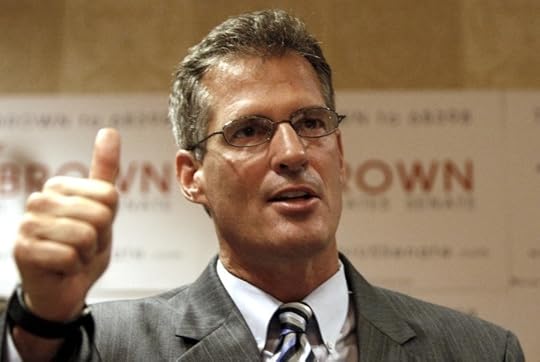 Associated Press
Associated Press Scott Brown showed up in New Hampshire this week to talk to the good people of the Granite State about how maybe he wants to be their senator because he likes how they don't wear motorcycle helmets.
Brown has been toying with the idea of running for Senate in New Hampshire's 2014 election. So he drove up there in his pick-up truck, the co-star of a number of the 2010 ads that propelled him to a House-length career in the U.S. Senate. Since the truck has Massachusetts license plates — Brown lives in Massachusetts and was previously the senator from Massachusetts — Politico reports that "liberals" "needled" Brown about it.
Those same liberals — a PAC with the clumsy name of American Bridge 21st Century — also released a video taped in August but only released on Thursday. Politico transcribes:
“You still have more freedoms than most here in New Hampshire,” Brown says... . “I love riding my motorcycle without my helmet. I will tell you that.”
There's a bit of irony that precedes that bit of pandering. He starts off by suggesting that the state motto is "Live Free and Die," not the correct "Live Free or Die." And he says that right before he praises the fact that he doesn't have to wear a motorcycle helmet because it's not mandated by law. Think about that.
We were curious the extent to which helmet laws affected motorcycle fatalities, so we pulled data from the Governors Highway Safety Association. There are only three states that don't mandate the use of a motorcycle helmet: Illinois, Iowa, and New Hampshire. The most recent data was for the first nine months of 2012. We mapped that as a function of deaths per 100,000 residents of the state:
Those three states without helmet laws are not outliers on this, according to this data. New Hampshire had 25 fatalities in the first nine months of last year, a rate of 1.89 deaths per 100,000 residents. A little above average, but not excessively. Vermont (1.76) and Maine (1.58) were pretty close. Massachusetts, though, was way lower — one-third that of New Hampshire.
According to studies reviewed by the University of Minnesota, the use of a helmet plays a significant role in preventing death despite that data. One study found a 69 percent decrease in the likelihood of death when using a helmet; another, that 45 percent of deaths were among those not wearing one. At higher speeds, a helmet makes less of a difference, but at lower speeds, it can clearly save your life.
The point being this: The "freedom" to ride a motorcycle without a helmet is a pretty stupid thing to celebrate. "Live Free and Die," sure. Or, better, "Give me liberty or give me death, or give me both in rapid succession so I don't mess up my hair." Scott Brown does have nice hair.












Robert Levinson, Who Disappeared in Iran in 2007, Was Working for the CIA
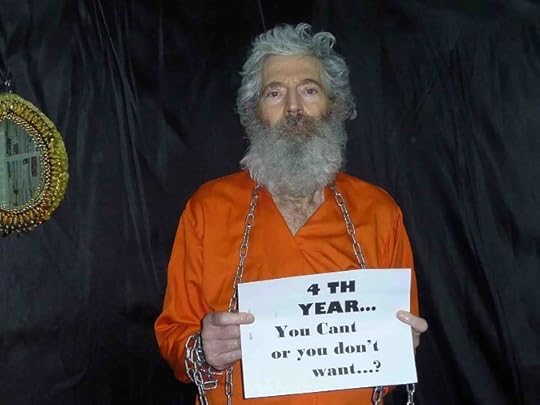 AP
AP Robert Levinson, an American who disappeared in Iran in 2007, was in the country working for the CIA, according to a report from the Associated Press's Matt Apuzzo and Adam Goldman. Levinson, whom the U.S. has said was in the country on private business as a private citizen at the time of his kidnapping, was actually on the CIA's payroll investigating the Iranian government. U.S. officials believe his captors are already aware of Levinson's connection to the CIA.
According to the report, Levinson probably shouldn't have been doing what he was doing. "In an extraordinary breach of the most basic CIA rules," the AP explains, Levinson was working for analysts who didn't have permission to run international spying operations for the agency. Levinson himself, a former Drug Enforcement Administration and FBI agent, was not properly trained to undertake that work. Levinson worked as a private investigator after retiring from the FBI in 1998. Once the CIA figured out that Levinson was, however unconventionally, working for them, the agency apparently went to great lengths to keep the breach of protocol quiet, even as the news of Levinson's disappearance attracted substantial public interest:
Behind closed doors, three veteran analysts were forced out of the agency and seven others were disciplined. The CIA paid Levinson's family $2.5 million to pre-empt a revealing lawsuit, and the agency rewrote its rules restricting how analysts can work with outsiders. But even after the White House, FBI and State Department officials learned of Levinson's CIA ties, the official story remained unchanged.
The AP learned of the CIA connection through a series of documents, along with "dozens" of interviews spanning several years with those involved in the mission to find Levinson. After agreeing to delay the story in 2010 based on a U.S. government request, the news agency changed its mind this year: "The AP is reporting the story now because, nearly seven years after his disappearance, those efforts [to rescue Levinson] have repeatedly come up empty." The last proof of life photos for Levinson were sent in 2011. Some U.S. officials believe Levinson is dead. Whether he is alive or not, U.S. and foreign officials seem to have no idea where he was taken.
The government's request for the AP to remain silent on what it knew about Levinson has come up at least once before — in 2011, the AP reported that it had proof the retired FBI agent was alive, only after Secretary of State Hillary Clinton made news of such evidence public knowledge. At the time, the AP said it had quite a lot more about the hostage, but couldn't discuss the details for fear of jeopardizing attempts to locate and free him.
In November, Levinson's son Dan wrote an op-ed in the Washington Post about the effort to find his father. "We respectfully request that the Rouhani administration help us find my father," Dan said of the new Iranian president, adding, "It’s not possible to overstate the nightmare that the past 6 years 8 months have been since my father, a retired FBI agent, disappeared while on a private business trip. My mother, four sisters, two brothers and I have tried to continue with our lives, but the situation weighs on us every day."
Yesterday, Florida lawmakers also asked Iran's government to help find Levinson, and President Obama brought up his disappearance during a historic phone conversation with Rouhani earlier this year. Rouhani has said in the past that he has no information on Levinson's location.
Read the whole, stunning AP report here.












'SNL' Is Looking to Add a Black Woman to Its Cast ASAP
 NBC
NBC Saturday Night Live is hoping to fix its big diversity problem very quickly. After reports emerged that the show was holding auditions exclusively for black women, The Hollywood Reporter's Seth Abramovitch and Lesley Goldberg reported that sources say the show "intends on adding one African-American woman to the cast as soon as this January." Update: Bill Carter of the New York Times reports that Lorne Michaels has confirmed this timeline. According to Carter, Michaels "had committed to that timetable to add the show’s first black woman since Maya Rudolph left the series in 2007."
This comes after the show faced widespread criticism over the fact that its incoming cast for this season was entirely white. In response, cast members began speaking out. Jay Pharaoh said that Darmirra Brunson should be cast "because she’s black first of all, and she’s really talented." Meanwhile, longtime cast member Kenan Thompson said in another interview that black women aren't cast because "in auditions, they just never find ones that are ready." By the time Kerry Washington hosted the show in November, the problem was so evident that the entire cold open ended up being about the hole in the show's cast.
Word started spreading over the past two days that the show held an audition showcase exclusively for black women. One actress, Bresha Webb, told the Jasmine BRAND that the "audition came about from an inside source from SNL. I don’t think any of us had a clue about the showcase until two days prior." (Jezebel compiled some examples of the work of the comedians on hand for the audition.) The Hollywood Reporter report further revealed that there were actually two showcase auditions held, and that the show is acting fast. Bradford Evans at Splitsider noted that "midseason has been a time when SNL has traditionally added talent, on occasion. With Seth Meyers most likely leaving to host NBC's Late Night around midseason, there'll be room in the cast and the show's budget for a new performer."
Fixing the very apparent problem in their cast is a big step for the show. Let's just hope that whoever is added is scrutinized the same way any new cast member would be, not more so because she was part of the show's attempt to correct their mistake.












Obama's Obamacare Lie is Politifact's 'Lie of the Year,' Which Is Always About Obamacare
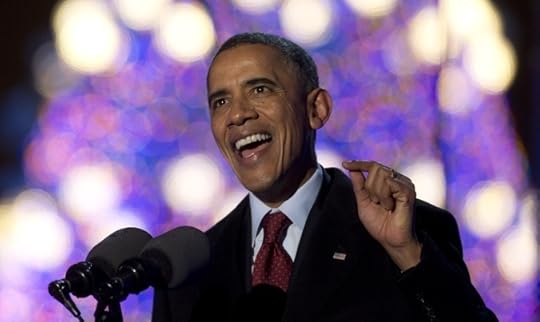 Associated Press
Associated Press President Obama's repeated insistence that people could keep their healthcare plans once Obamacare kicked in was named Politifact's "Lie of the Year" — the fourth time in five years the "Lie of the Year" has been about this one health care law.
There were solid odds that some Obamacare "lie" would be the winner, given that six of the 10 finalists selected by the fact-checking organization (which is part of the Tampa Bay Times) involved the law in one way or another. It was also likely to be this particular "pants on fire"-ranked statement given its significance in the public debate over the past few months. Perhaps if Health and Human Services Secretary Kathleen Sebelius had sworn under oath that Healthcare.gov would work perfectly on October 1, that might usurp the title. But as the supercut compiled by New York magazine suggests, this was pretty inescapable for Obama.
Here's how Politifact described the award-winner.
Boiling down the complicated health care law to a soundbite proved treacherous, even for its promoter-in-chief. Obama and his team made matters worse, suggesting they had been misunderstood all along. The stunning political uproar led to this: a rare presidential apology.
It also points out that three of the previous four winners since "lie of the year" was inaugurated in 2009 have been about Obamacare. The legislation "has been subject to more erroneous attacks than any other piece of legislation PolitiFact has fact-checked," Angie Drobnic Holan writes for the site.
In fact, it was only in the wake of last year's presidential election that the winner wasn't about Obamacare. In 2012, Mitt Romney only won one contest, handed the "lie of the year" designation for his insistence in campaign ads that Jeep was moving production to China. It wasn't and isn't.
Otherwise, the winners break down like this:
In 2009, Sarah Palin won, for her insistence that Obamacare would include "death panels." In 2010, it was Republican consultant Frank Luntz's assertion that Obamacare would lead to a "government take over of health care." In 2011, various Democrats were given the title for saying that Republicans had voted to end Medicare.Obama can find some consolation in that history. Palin has been unchastened by the ignominious distinction, continuing even this year to claim that death panels exist. And the right continues to suggest that Obamacare amounts to a government takeover. It would be hard for Obama to backtrack at this point, but given that he's termed out anyway, he should feel perfectly free to pick this line back up in 2015 or so. By then, there will have been another two Obamacare-related lies of the year to muddy the waters.












North Korea Executed Kim Jong Un's Uncle
 AP
AP North Korea said on Thursday that its government had executed Jang Song Thaek, the uncle of leader Kim Jong Un. Until recently, Jang was widely regarded as the second most powerful man in the country. The state-run KCNA news agency called Jang a "traitor," claiming that he "brought together undesirable forces" in the country to form an opposition faction. His removal from power, and ultimate execution, is likely part of Kim's broader strategy to consolidate power.
Weeks ago, images and mentions of Jang began to disappear from North Korea's state-produced media, indicating that some sort of purging was afoot. This week, it became clear that his removal from power was something more than a momentary falling out between the two when the state-run media accused Jang of fomenting dissent, womanizing, gambling, and using drugs. On Sunday, the country's state-run news agency broadcast images of Jang being forcibly removed from an emergency meeting of the country's ruling party. Jang was purged once before, in 2004, under Kim Jong Il's rule.
The KCNA report on Jang's execution goes even further to demonize the character of Kim's former mentor, calling him "Despicable human scum" and "worse than a dog:"
From long ago, Jang had a dirty political ambition. He dared not raise his head when Kim Il Sung and Kim Jong Il were alive. But, reading their faces, Jang had an axe to grind and involved himself in double-dealing. He began revealing his true colors, thinking that it was just the time for him to realize his wild ambition in the period of historic turn when the generation of the revolution was replaced.
"Jang committed such an unpardonable thrice-cursed treason as overtly and covertly standing in the way of settling the issue of succession to the leadership," KCNA continued. Reportedly, North Korea also executed some of Jang's associates.












December 11, 2013
International Space Station Suffers Malfunction
 Russian cosmonaut Fyodor Yurchikhin participates in a spacewalk outside the International Space Station on Friday, Aug. 16, 2013. (AP/NASA)
Russian cosmonaut Fyodor Yurchikhin participates in a spacewalk outside the International Space Station on Friday, Aug. 16, 2013. (AP/NASA) Although it poses no immediate threat to the astronauts in orbit, a malfunctioning cooling pump on the International Space Station required maintenance on Wednesday. A NASA spokesman announced that "one of the station’s two external cooling loops shut down because it was too cool Wednesday afternoon," in maybe the only case ever of something being so damn cool that it was straight-up dangerous. Non-critical equipment was powered down because of the failure.
Engineers at mission control diagnosed the problem as an issue with a valve inside the pump, and shifted power to a second cooling loop. If ground crews are unable to sort the problem out, the astronauts on board might have to plan a spacewalk in order to fix the issue. A similar failure occurred on the ISS without much incident in 2010. According to the admirably casual ISS Twitter feed, the station currently has three spare pump modules.
Loop A NH3 outlet temp reached a minimum of -34.7°C and is now warming up again. Loop B is coping well with the additional loads. #ISS
— ISS Updates (@ISS101) December 12, 2013
The situation has not yet been fully resolved, but the six astronauts—two American, three Russian, and one Japanese—are not in immediate danger and "fine for the near future."












Atlantic Monthly Contributors's Blog
- Atlantic Monthly Contributors's profile
- 1 follower



